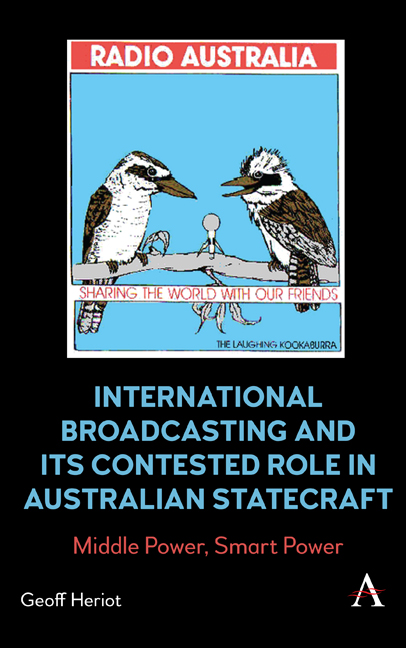 International Broadcasting and Its Contested Role in Australian Statecraft
International Broadcasting and Its Contested Role in Australian Statecraft Book contents
- Frontmatter
- Dedication
- Contents
- List of Figures
- Foreword
- Acknowledgements
- Chapter One Introduction
- Chapter Two Media and the Contest of Ideas
- Chapter Three International Broadcasting and Its Discursive Properties
- Chapter Four Mobilising ‘Softer’ Power in a Hard World
- Chapter Five Australia’s ABC: State Interests, National Evolution
- Chapter Six Purpose, Performance and Evaluation
- Chapter Seven Modernising the ABC
- Chapter Eight Policy, Priorities and Qualified Independence
- Chapter Nine Engaging with Intercultural Audiences
- Chapter Ten Indonesia, the Crucible
- Chapter Eleven Strategic Contingency and War
- Chapter Twelve Looking to the New Disorder
- Index
Chapter Three - International Broadcasting and Its Discursive Properties
Published online by Cambridge University Press: 15 November 2023
- Frontmatter
- Dedication
- Contents
- List of Figures
- Foreword
- Acknowledgements
- Chapter One Introduction
- Chapter Two Media and the Contest of Ideas
- Chapter Three International Broadcasting and Its Discursive Properties
- Chapter Four Mobilising ‘Softer’ Power in a Hard World
- Chapter Five Australia’s ABC: State Interests, National Evolution
- Chapter Six Purpose, Performance and Evaluation
- Chapter Seven Modernising the ABC
- Chapter Eight Policy, Priorities and Qualified Independence
- Chapter Nine Engaging with Intercultural Audiences
- Chapter Ten Indonesia, the Crucible
- Chapter Eleven Strategic Contingency and War
- Chapter Twelve Looking to the New Disorder
- Index
Summary
The networks and applications of twenty-first-century communications technology have broadened media access massively while having the effect of amplifying and intensifying the force of political messaging. Yet a conceptual through line can be drawn between the character and organising principles of twentieth-century international broadcasting and those of today. This chapter offers an overview of the rise and character of international broadcasting as practised by totalitarian/authoritarian and democratic states. It also examines the conditions and processes of communicative exchange required for a broadcaster to engage with and predispose target audiences to influence and persuasion. As an agent of the state in international politics since World War II, international broadcasting has straddled competing ‘efforts to spread information and efforts to control its spread’ (Shaheed 2019, p. 4). The practice has been deployed for benign or hostile purposes, to build trust, to proselytise or to wage psychological warfare.
A correspondent of Moscow’s Novosti news agency, Karl Nepomnyashchi, claimed that American, German and Canadian broadcasters had been ‘the real masters of the black heavens’ during the Cold War (Short 1986, p. 4). He spoke of their ‘vile role’ (Nelson 1997, p. vi) in circumventing the Soviet Union’s control of information during its invasion of Czechoslovakia in August 1968. So long as listeners had access to high-frequency (shortwave) radio receivers, they could circumvent the censorship imposed by their own governments. Shortwave offered the facility of long-distance transmissions that could not be blocked except at considerable expense. In 1984, Indonesian scholar Juwono Sudarsono commented that the Western media presence constituted ‘one of the more powerful instruments of power projection by the United States and its democratic allies’ (Sudarsono 1984). Two decades later, in March 2005, Radio Australia’s Hidayat Djajamihardja recalled how the bellboy of a hotel in Dili pursued him across the foyer, wishing to make a ‘courtesy call’ on the Indonesian-born broadcast journalist (Djajamihardja 2005). They had never met. But that voice! Without hesitation the bellboy recognised its cadence and timbre. He told Hidayat of the years under Indonesian occupation of East Timor when local people lowered the volume on their shortwave radio receivers so they could listen, undetected, to the news from Radio Australia.
- Type
- Chapter
- Information
- International Broadcasting and Its Contested Role in Australian StatecraftMiddle Power, Smart Power, pp. 35 - 60Publisher: Anthem PressPrint publication year: 2023


